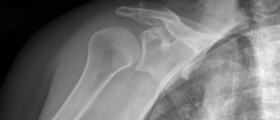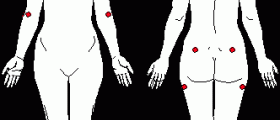
Frozen shoulder, as its name mightsuggest, is a condition which manifests through stiffness and pain inthe joint of the shoulder. This condition commonly appears as a mildone in the beginning, evolving into a serious health problem lateron. However, over the course of a year of two, the symptoms offrozen shoulder commonly subside.
People who are most likely to sufferfrom this form of injury are those who have already compromised theirhealth by having suffered from strokes or mastectomy, affecting themobility of their arms negatively.
Either way, the treatment for frozenshoulder is quite a simple one, including certain stretches and someother forms of exercises, along with corticosteroid injectionsadministered into the capsule of the affected joint. Yet, in someextreme cases, where all alternatives have been found useless,surgery may be necessary.
Pain with Frozen Shoulder
Frozen shoulder, as a medical conditionhas several phases that it manifests through. Initially, one feelsthe pain during the “freezing” phase. This phase delivers painand stiffness, disallowing one to move the affected shoulder more andmore. All the symptoms of this phase usually get worse duringnighttime, mainly due to the fact that numerous sufferers risk lyingonto the affected shoulder accidentally during this time.
The second phase of the frozen shoulderis the stiff phase or the “frozen” phase. While the previousphase may last from 2 to 9 months, this one lasts from 2 to 12months, limiting the movement capabilities even further, making itimpossible to move the arm outwards. During this stage, there aregreat chances that the shoulder muscles may get damaged from notbeing used for a long time.
The final or “thawing” phase isalso known as the recovery phase, where the process may last from 5months to four years. Here, the pain and stiffness begin disappearinggradually, restoring movement completely or partially.
Due to the pain that goes hand-in-handwith this condition, it might be very hard to perform some commondaily tasks such as driving, scratching the back, putting on clothesor sleeping. Naturally, this can affect work and all other aspects oflife, making a person less productive and frustrated.
When this condition is neglected andnot treated, it usually bothers a person for about 3 years in total.
As for the risk factors related tofrozen shoulder, 1 in every 50 people suffers from this condition ata particular part of his/her life, most commonly between the 40thand the 60th year of life. Nevertheless, women are moresusceptible to frozen shoulder, as well as people suffering fromdiabetes, hyperthyroidism and Parkinson's disease.
Finally, this condition usually affectsthe shoulder which is less active, even though in every 5thsufferer the condition spreads onto the other shoulder too.
Physical Therapy for Pain Relief
Before any treatment can take place,your health provider will need to perform a physical examination ofthe affected shoulder, diagnosing the condition. Then, once thediagnosis is complete, you will likely be prescribed with painkillersin order to cope with the pain and discomfort typical with the frozenshoulder condition.
The painkillers may be ordinary onessuch as codeine or paracetamol, or some anti-inflammatory ones suchas ibuprofen, diclofenac and naproxen, helping you deal with theswelling and the inflammation present in the shoulder area.
Furthermore, regular exercises willprevent any permanent muscle damage from affecting the shoulder.Also, keeping this area physically active will keep excessivestiffness at bay. Thus, some other forms of physical therapy may beprescribed, along with pain-relieving activities such as coldexposure and TENS machines.
Even though physical manipulation ofthe affected shoulder can prove to be excellent for quickening therecovery, this process should be carried out carefully, since manyside-effect may appear otherwise. Arthroscopic release has beenproven good for restoring motion, leading to a decrease of pain anddiscomfort, even though many patients experience a permanent decreasein their motor functions once the frozen shoulder condition subsidescompletely.
Alternatively, full external rotationof the humerus while keeping the elbow in a relaxed position is alsoknown to be helpful, even though this form of treatment is hard toadminister in case of severe adhesive capsulitis in its most seriousstages.
All in all, frozen shoulder is acondition manifesting through pain and stiffness affecting one'sshoulder area, resulting in pain and discomfort preventing a personfrom performing many daily actions and activities. The condition,when not treated, usually remains present for about 3 years, gettingworse before disappearing gradually on its own. However, it is bestnot to ignore this condition since avoiding shoulder movement canlead to serious long-term effects.
Thus, if you suffer form frozenshoulder, seek medical assistance on time. Your doctor will examineyou and diagnose your condition, administering the necessarymedications and starting you on adequate forms of physical therapy.










-Symptoms,-Diagnosis,-Treatment_f_280x120.jpg)






Your thoughts on this
Loading...